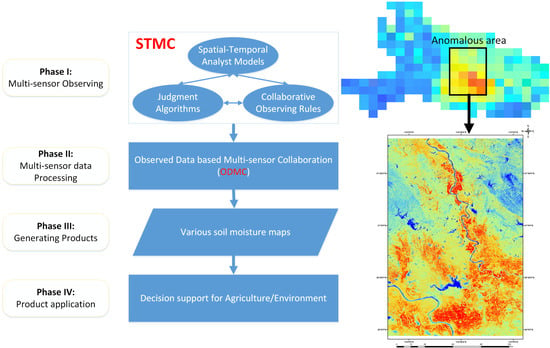Spatial Pattern and Temporal Variation Law-Based Multi-Sensor Collaboration Method for Improving Regional Soil Moisture Monitoring Capabilities
Abstract
:1. Introduction
2. STMC Method
2.1. Overview of the STMC

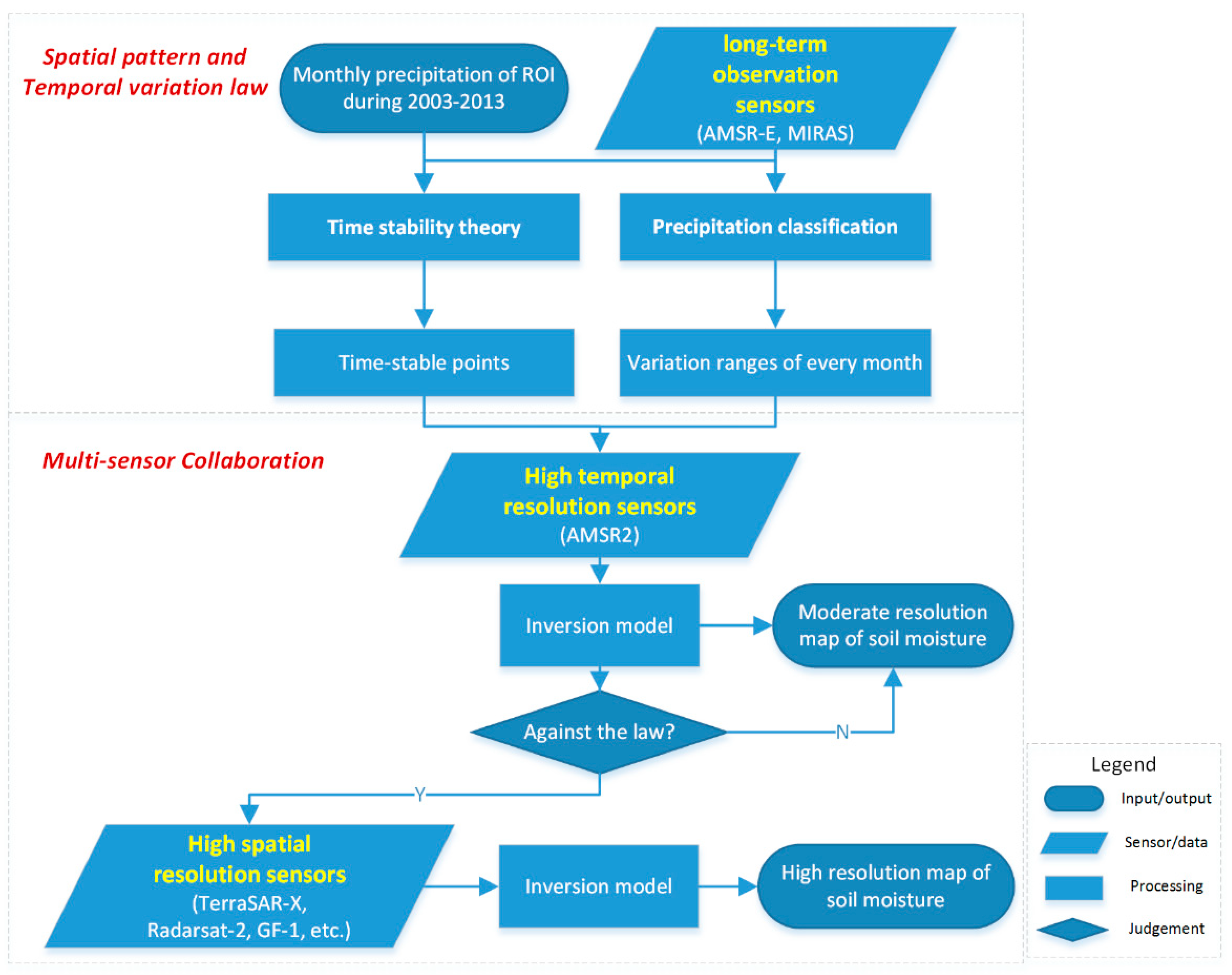
2.2. Spatial Pattern and Temporal Variation Law
| Classification Factors | Classification Rules | Resulting in Soil Moisture |
|---|---|---|
| PAPi ≤ −20% | Drought month | Potential drought |
| −20% < PAPi ≤ −10% | Light drought month | Lower limit of normal soil moisture |
| −10% < PAPi < 10% | Normal precipitation month | Normal soil moisture month |
| 10% ≤ PAPi < 20% | Light waterlogging month | Upper limit of normal soil moisture |
| PAPi ≥ 20% | Waterlogging month | Potential waterlogging |
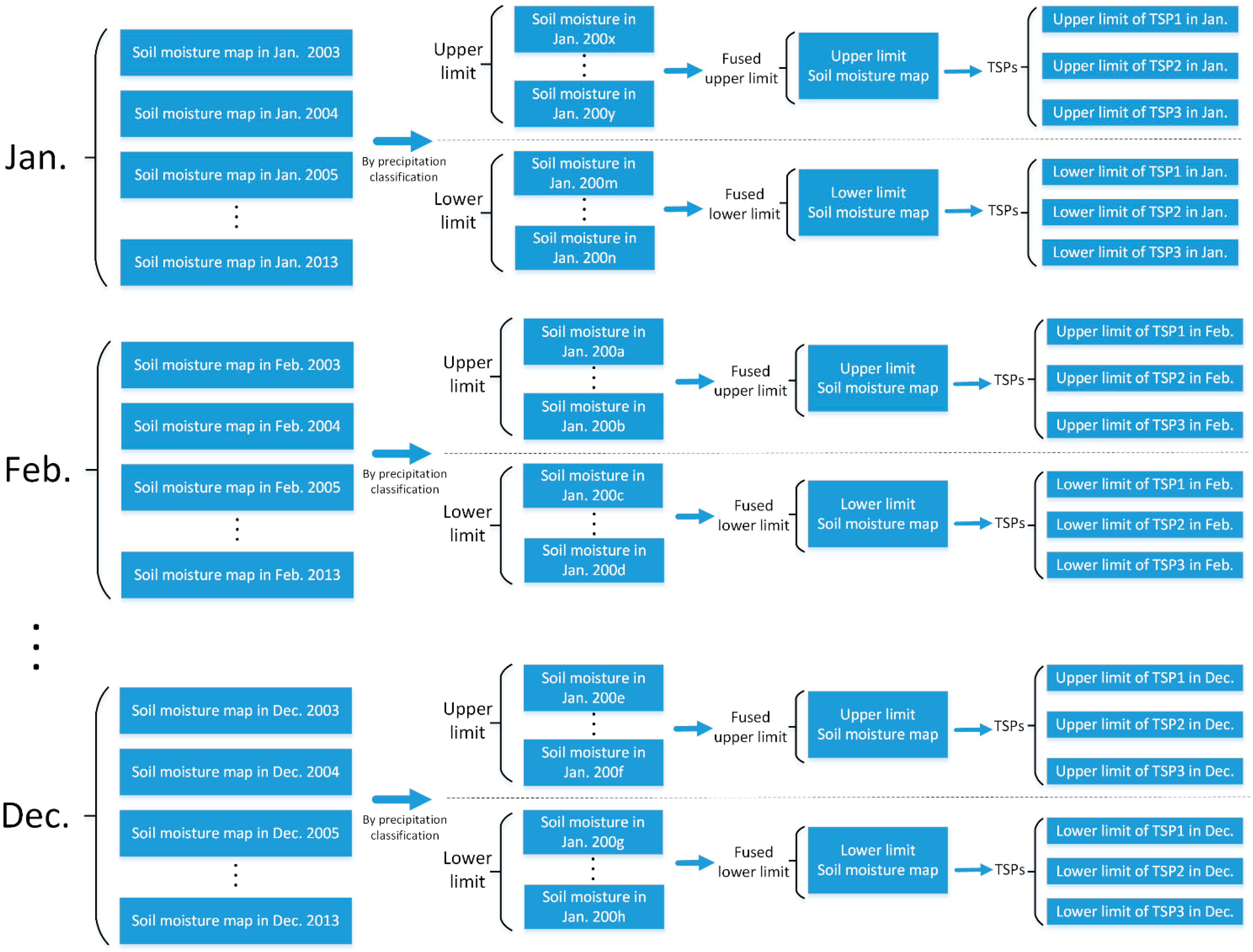
2.3. Multi-Sensor Collaboration
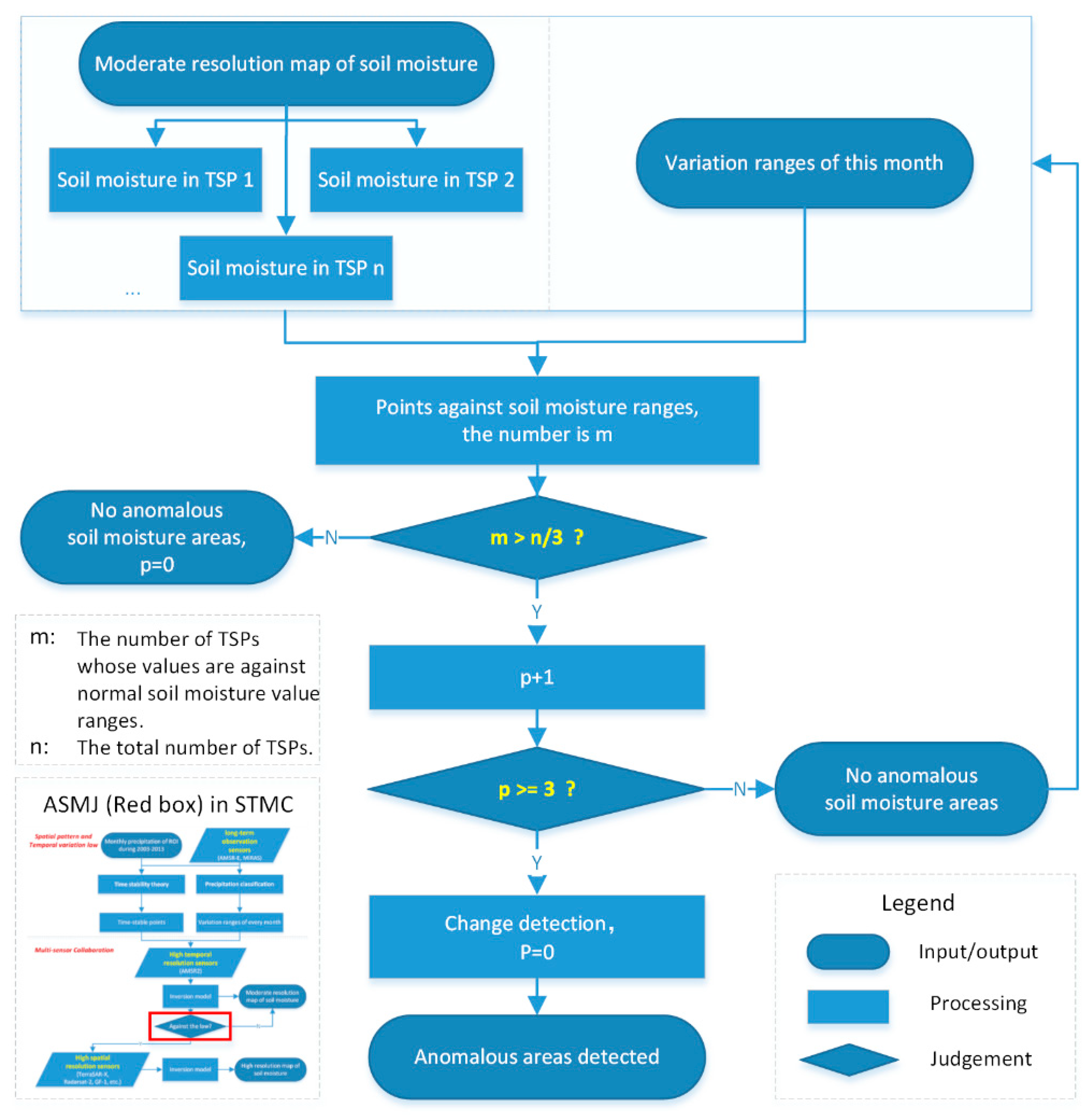
3. Study Area and Dataset
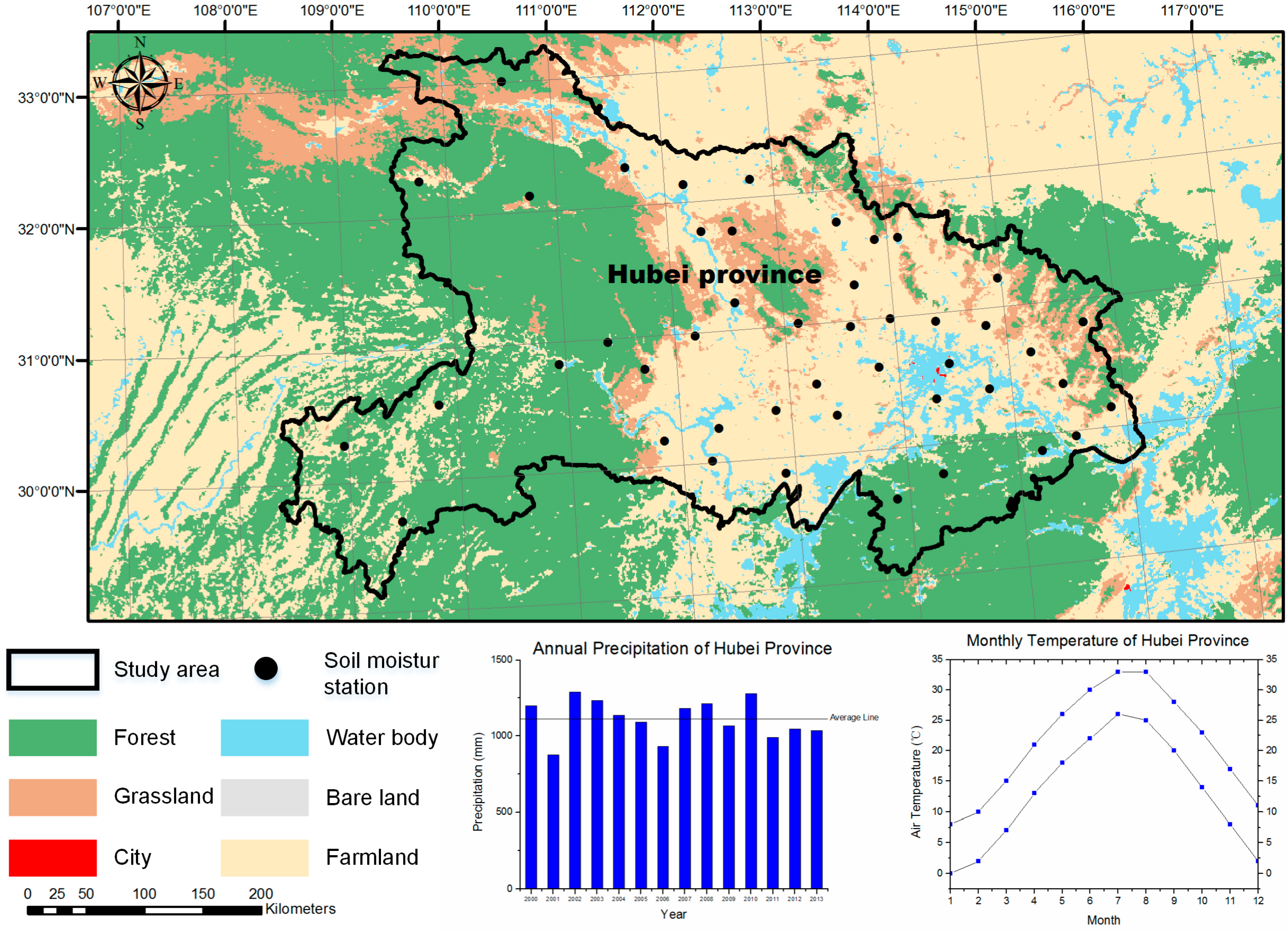
| Year | Monthly Precipitation in Hubei Province (mm) | |||||||||||
|---|---|---|---|---|---|---|---|---|---|---|---|---|
| Jan. | Feb. | Mar. | Apr. | May | Jun. | Jul. | Aug. | Sep. | Oct. | Nov. | Dec. | |
| 2003 | 46.1 | 57.4 | 77.4 | 138.5 | 171.2 | 227.2 | 210.1 | 141.0 | 76.0 | 68.9 | 51 | 25.3 |
| 2004 | 30.9 | 45.3 | 68.1 | 125.6 | 186.6 | 215.9 | 189.0 | 113.9 | 83.1 | 74.8 | 47.4 | 17.1 |
| 2005 | 31.1 | 53.4 | 104.8 | 125.9 | 137.8 | 178.8 | 194.3 | 107.2 | 74.8 | 87.5 | 68.7 | 22.7 |
| 2006 | 38.4 | 40.3 | 78.5 | 76.3 | 104.9 | 147.2 | 197.5 | 62.6 | 81.2 | 56.8 | 46.5 | 19.6 |
| 2007 | 44.7 | 48.6 | 85.6 | 140.2 | 94.2 | 187.5 | 154.4 | 113.8 | 88.6 | 76.3 | 56.1 | 51.9 |
| 2008 | 25.1 | 66.5 | 88.9 | 89.4 | 118.7 | 284.4 | 98.8 | 99.4 | 77.5 | 101.7 | 62.4 | 44.5 |
| 2009 | 24.0 | 57.9 | 104.2 | 123.2 | 111.5 | 177.9 | 204.7 | 79.6 | 74.9 | 74.6 | 31.0 | 39.4 |
| 2010 | 47.2 | 62.8 | 91.6 | 110.9 | 163.3 | 272.6 | 188.2 | 130.5 | 112.8 | 96.8 | 65.3 | 45.7 |
| 2011 | 42.8 | 39.6 | 84.7 | 84.2 | 114.9 | 108.3 | 117.3 | 124.8 | 87.3 | 68.5 | 21.6 | 29.8 |
| 2012 | 12.4 | 41.5 | 93.0 | 129.8 | 174.6 | 227.5 | 178.1 | 99.6 | 89.6 | 55.7 | 54.9 | 38.4 |
| 2013 | 34.6 | 50.3 | 87.2 | 95.4 | 177.7 | 189.3 | 134.2 | 110.9 | 67.2 | 45.5 | 56.8 | 29.2 |
4. Experiment Results
4.1. Spatial Pattern Law of Soil Moisture
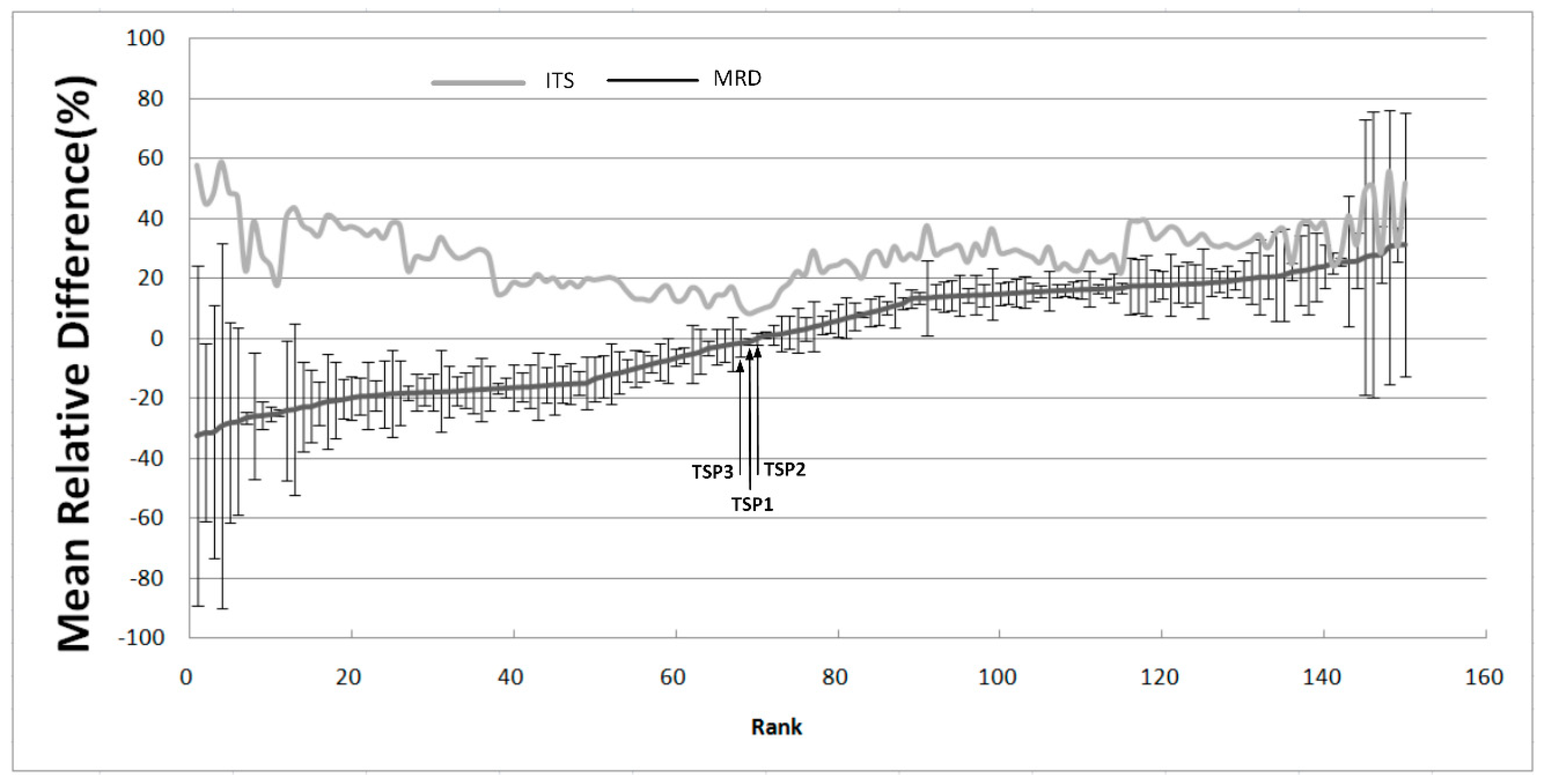
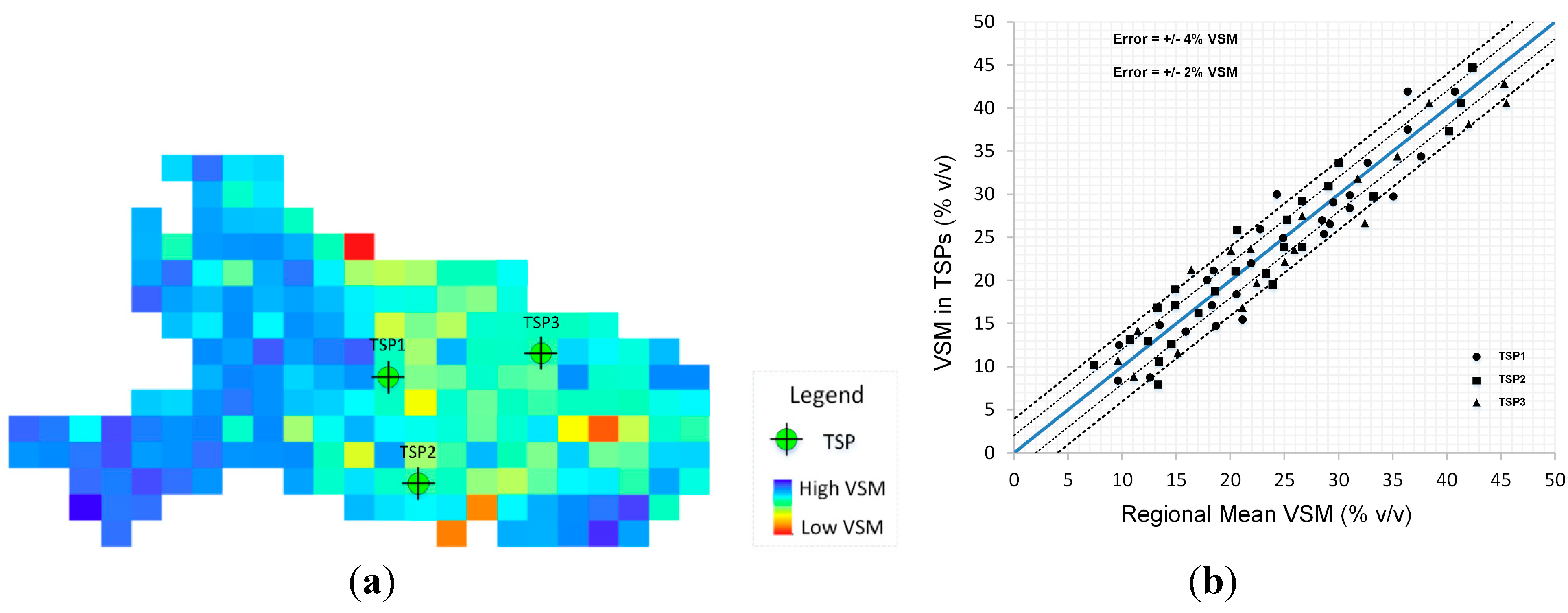
4.2. Temporal Variation Law of Soil Moisture
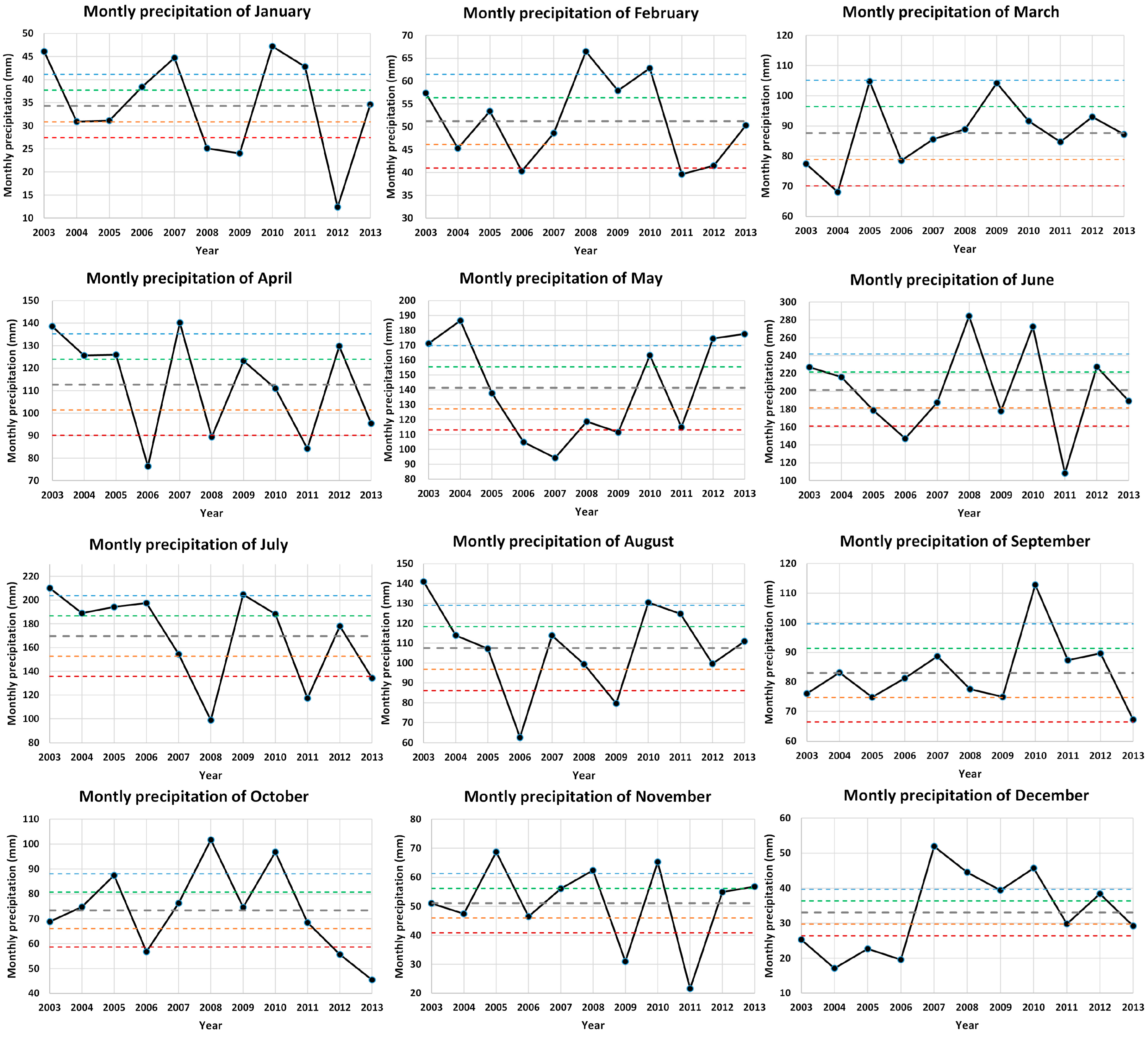

4.3. Multi-Sensor Collaboration for Hubei Province Soil Moisture Monitoring

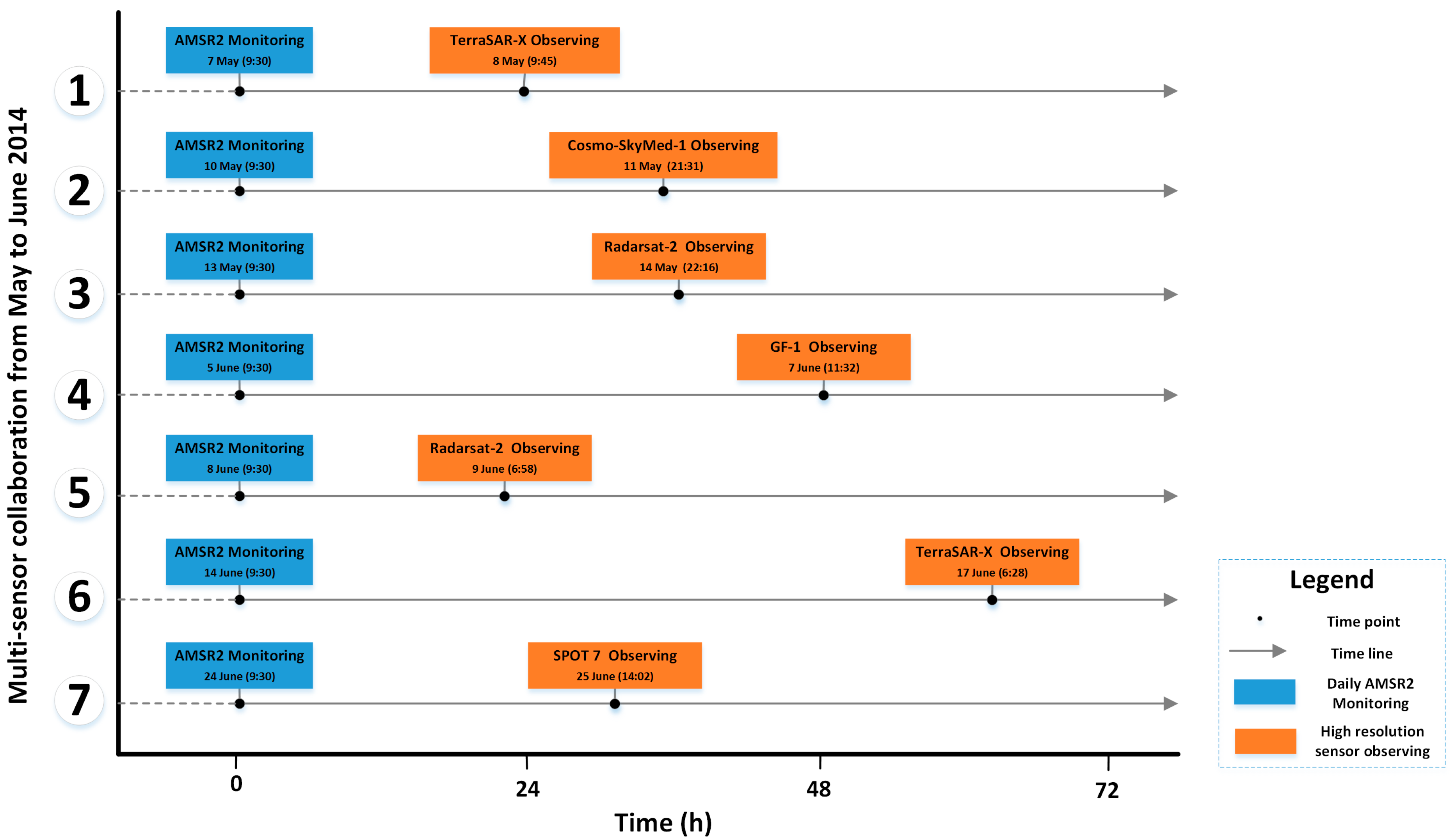
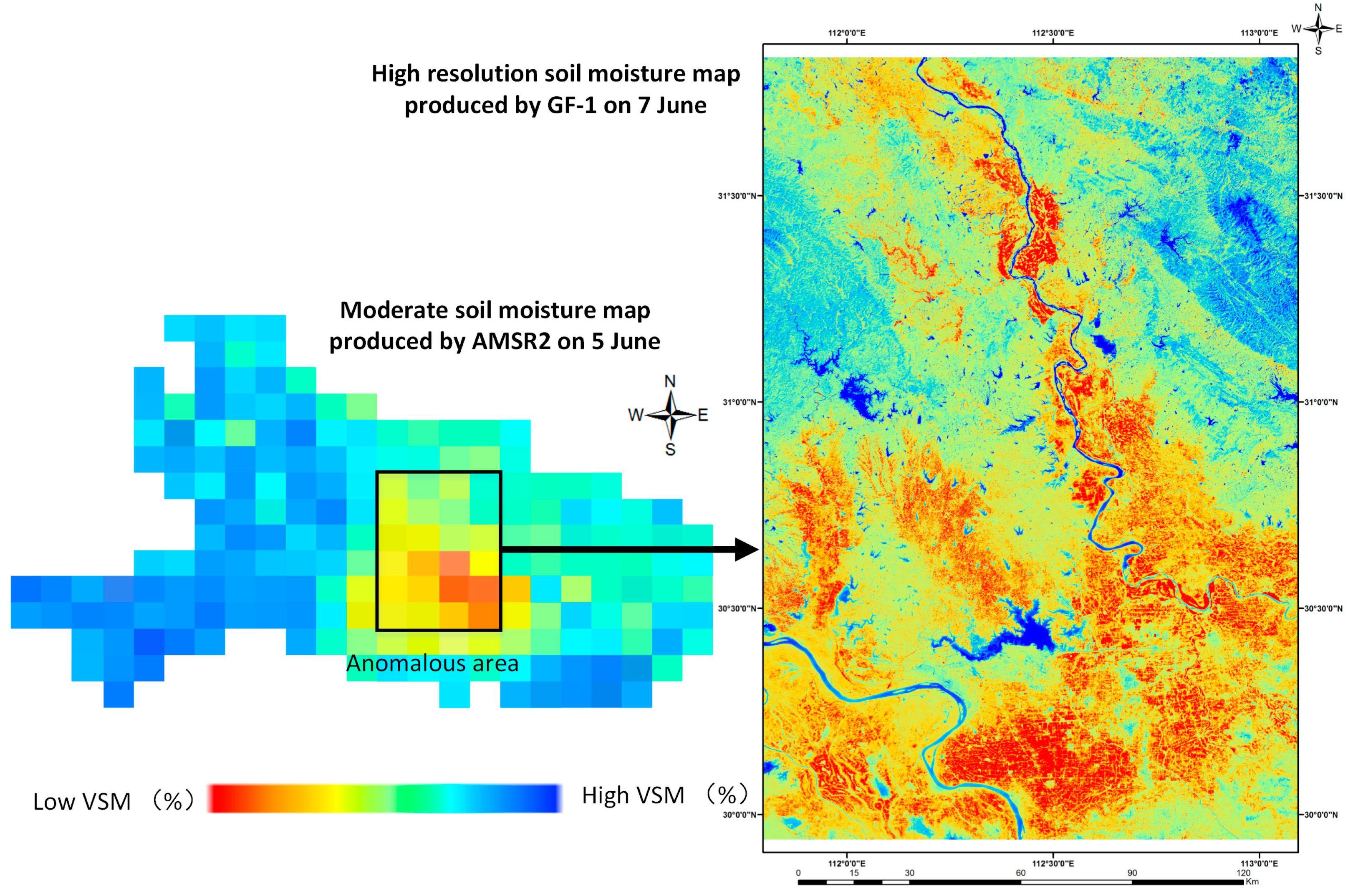
5. Discussion
5.1. Accuracy Test of Daily AMSR2 Monitoring
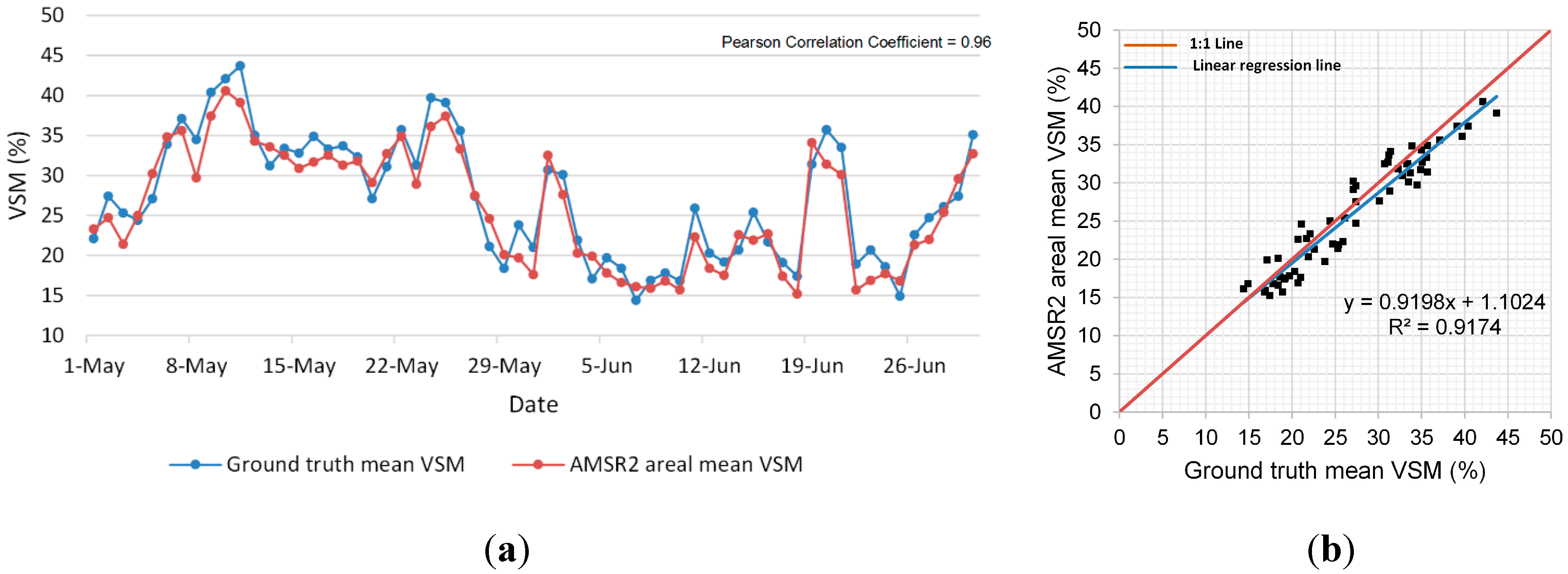
5.2. Comparison with the ODMC Method
| Aspects | ODMC Method | STMC Method |
|---|---|---|
| Phase | Data application | Data acquiring |
| Input | Multi-sensor’s data | Multi-sensor’s Observation capabilities |
| Focus | Assimilation model, fusion algorithms | Observation strategy |
| Output | More valuable processed data or information | More efficient and timely multi-sensor’s raw data or information |
| Headroom | Middle | High |
5.3. Comparison with Other Related Methods
| Approaches | Object | Judgment Data | Judgment Method | Collaborated Sensors/Satellites |
|---|---|---|---|---|
| Mandl et al. [29,30] | Forest fire | Thermal bands | Thresholds | MODIS, Hyperion, ALI |
| Liu et al. [31] | Forest fire | Near-infrared band | Spatial statistics, hot-spots index | MODIS, Formosat-2 |
| Martinis et al. [32] | Flood | Multispectral bands | Water and vegetation indices | MODIS, TerraSAR-X |
| Lacava et al. [33] | Flood | Near-infrared and visible bands, microwave data | Water indices | MODIS, AMSR-E |
| The proposed STMC method | Soil moisture | Long sequence microwave data | Spatial pattern and temporal variation law | AMSR-E, MIRAS, AMSR2, TerraSAR-X, etc. |
5.4. Merits and Limitations
6. Conclusions
Acknowledgments
Author Contributions
Conflicts of Interest
References
- McNairn, H.; Merzouki, A.; Pacheco, A.; Fitzmaurice, J. Monitoring soil moisture to support risk reduction for the agriculture sector using RADARSAT-2. IEEE J. Sel. Top. Appl. Earth Obs. Remote Sens. 2012, 5, 824–834. [Google Scholar] [CrossRef]
- Tombul, M. Mapping field surface soil moisture for hydrological modeling. Water Resour. Manag. 2007, 21, 1865–1880. [Google Scholar] [CrossRef]
- Robinson, D.A.; Campbell, C.S.; Hopmans, J.W.; Hornbuckle, B.K.; Jones, S.B.; Knight, R.; Ogden, F.; Selker, J.; Wendroth, O. Soil moisture measurement for ecological and hydrological watershed-scale observatories: A review. Vadose Zone J. 2008, 7, 358–389. [Google Scholar] [CrossRef]
- Zhu, Q.; Liao, K.H.; Xu, Y.; Yang, G.S.; Wu, S.H.; Zhou, S.L. Monitoring and prediction of soil moisture spatial-temporal variations from a hydropedological perspective: A review. Soil Res. 2012, 50, 625–637. [Google Scholar] [CrossRef]
- Zhang, M.; Li, M.Z.; Wang, W.Z.; Liu, C.H.; Gao, H.J. Temporal and spatial variability of soil moisture based on WSN. Math Comput. Model 2013, 58, 820–827. [Google Scholar]
- Garcia-Estringana, P.; Latron, J.; Llorens, P.; Gallart, F. Spatial and temporal dynamics of soil moisture in a Mediterranean mountain area (Vallcebre, NE Spain). Ecohydrology 2013, 6, 741–753. [Google Scholar]
- Loew, A. Impact of surface heterogeneity on surface soil moisture retrievals from passive microwave data at the regional scale: The upper Danube case. Remote Sens. Environ. 2008, 112, 231–248. [Google Scholar] [CrossRef]
- Kerr, Y.H. Soil moisture from space: Where are we? Hydrogeolo. J. 2007, 15, 117–120. [Google Scholar] [CrossRef]
- Baghdadi, N.; Camus, P.; Beaugendre, N.; Issa, O.M.; Zribi, M.; Desprats, J.F.; Rajot, J.L.; Abdallah, C.; Sannier, C. Estimating surface soil moisture from TerraSAR-X data over two small catchments in the Sahelian part of Western Niger. Remote Sens. 2011, 3, 1266–1283. [Google Scholar] [CrossRef] [Green Version]
- Parde, M.; Zribi, M.; Wigneron, J.P.; Dechambre, M.; Fanise, P.; Kerr, Y.; Crapeau, M.; Saleh, K.; Calvet, J.C.; Albergel, C.; et al. Soil moisture estimations based on airborne CAROLS L-Band microwave data. Remote Sens. 2011, 3, 2591–2604. [Google Scholar] [CrossRef] [Green Version]
- Camps, A.; Font, J.; Corbella, I.; Vall-Llossera, M.; Portabella, M.; Ballabrera-Poy, J.; Gonzalez, V.; Piles, M.; Aguasca, A.; Acevo, R.; et al. Review of the CALIMAS team contributions to European Space Agency’s soil moisture and ocean salinity mission calibration and validation. Remote Sens. 2012, 4, 1272–1309. [Google Scholar]
- Barrett, B.W.; Dwyer, E.; Whelan, P. Soil moisture retrieval from active spaceborne microwave observations: An evaluation of current techniques. Remote Sens. 2009, 1, 210–242. [Google Scholar] [CrossRef]
- Cai, G.; Xue, Y.; Hu, Y.; Wang, Y.; Guo, J.; Luo, Y.; Wu, C.; Zhong, S.; Qi, S. Soil moisture retrieval from MODIS data in Northern China Plain using thermal inertia model. Int. J. Remote Sens. 2007, 28, 3567–3581. [Google Scholar] [CrossRef]
- Jian, J.; Yang, W.N.; Jiang, H.; Wan, X.N.; Li, Y.X.; Peng, L. A model for retrieving soil moisture saturation with Landsat remotely sensed data. Int. J. Remote Sens. 2012, 33, 4553–4566. [Google Scholar] [CrossRef]
- Remote Sensors List Used in Surface Soil Moisture Monitoring Analyzed by Observation Systems Capability Analysis and Review tool (OSCAR). Available online: http://www.wmo-sat.info/oscar/gapanalyses?view=149 (accessed on 16 July 2014).
- Gherboudj, I.; Magagi, R.; Berg, A.A.; Toth, B. Soil moisture retrieval over agricultural fields from multi-polarized and multi-angular RADARSAT-2 SAR data. Remote Sens. Environ. 2011, 115, 33–43. [Google Scholar] [CrossRef]
- Chen, C.F.; Valdez, M.C.; Chang, N.B.; Chang, L.Y.; Yuan, P.Y. Monitoring spatiotemporal surface soil moisture variations during dry seasons in Central America with multisensory cascade data fusion. IEEE J. Sel. Top. Appl. Earth Obs. Remote Sens. 2014, 1–16. [Google Scholar]
- Pajares, G. Sensors in collaboration increase individual potentialities. Sensors 2012, 12, 4892–4896. [Google Scholar] [CrossRef] [PubMed]
- Kim, J.; Hogue, T.S. Improving spatial soil moisture representation through integration of AMSR-E and MODIS products. IEEE Trans. Geosci. Remote Sens. 2012, 50, 446–460. [Google Scholar] [CrossRef]
- Prakash, R.; Singh, D.; Pathak, N.P. A fusion approach to retrieve soil moisture with SAR and optical data. IEEE J. Sel. Top. Appl. Earth Obs. Remote Sens. 2012, 5, 196–206. [Google Scholar] [CrossRef]
- Hosseini, M.; Saradjian, M.R. Soil moisture estimation based on integration of optical and SAR images. Can. J. Remote Sens. 2011, 37, 112–121. [Google Scholar] [CrossRef]
- Sun, W.; Xu, G.; Gong, P.; Liang, S. Fractal analysis of remotely sensed images: A review of methods and applications. Int. J. Remote Sens. 2006, 27, 4963–4990. [Google Scholar] [CrossRef]
- Burrough, P.A. Multiscale sources of spatial variation in soil. I. The application of fractal concepts to nested levels of soil variation. Eur. J. Soil Sci. 1983, 34, 557–597. [Google Scholar]
- Delin, K.A. The sensor web: A macro-instrument for coordinated sensing. Sensors 2002, 2, 270–285. [Google Scholar] [CrossRef]
- Kooistra, L.; Bergsma, A.; Chuma, B.; Bruin, S.D. Development of a dynamic web mapping service for vegetation productivity using earth observation and in situ sensors in a sensor web based approach. Sensors 2009, 9, 2371–2388. [Google Scholar] [CrossRef] [PubMed]
- Meillet, P.M. Sensor webs: A geostrategic technology for integrated earth sensing. IEEE J. Sel. Top. Appl. Earth Obs. Remote Sens. 2010, 3, 473–480. [Google Scholar] [CrossRef]
- Di, L.P.; Moe, K.; van Zyl, T.L. Earth observation sensor web: An overview. IEEE J. Sel. Top. Appl. Earth Obs. Remote Sens. 2010, 3, 415–417. [Google Scholar] [CrossRef]
- Torres-Martinez, E.; Paules, G.; Schoeberg, M.; Kalb, M.W. A web of sensors: Enabling the earth science vision. Acta Astronaut. 2003, 53, 423–428. [Google Scholar] [CrossRef]
- Mandl, D. Experimenting with sensor webs using earth observing 1. In Proceedings of the IEEE Aerospace Conference, Big Sky, MT, USA, 6–13 March 2004; pp. 176–183.
- Chien, S.; Cichy, B.; Davies, A.; Tran, D.; Rabideau, G.; Castano, R.; Sherwood, R.; Nghiem, S.; Mandl, D.; Frye, S.; et al. An autonomous earth observing sensor web. In Proceedings of the IEEE International Conference on Sensor Networks, Ubiquitous, and Trustworthy Computing, Taichung, Taiwan, 5–7 June 2006; pp. 178–185.
- Liu, C.; Wu, A.; Yen, S.; Huang, C. Rapid locating of fire points from Formosat-2 high spatial resolution imagery: Example of the 2007 California wildfire. Int. J. Wildland Fire 2009, 18, 415–422. [Google Scholar] [CrossRef]
- Martinis, S.; Twele, A.; Strobl, C.; Kersten, J.; Stein, E. A multi-scale flood monitoring system based on fully automatic MODIS and TerraSAR-X processing chains. Remote Sens. 2013, 5, 5598–5619. [Google Scholar] [CrossRef]
- Lacava, T.; Brocca, L.; Coviello, I.; Faruolo, M.; Pergola, N.; Tramutoli, V. Integration of optical and passive microwave satellite data for flooded area detection and monitoring. In Engineering Geology for Society and Territory; Lollino, G., Arattano, M., Rinaldi, M., Giustolisi, O., Marechal, J.C., Grant, G.E., Eds.; Springer International Publishing AG: Cham, Switzerland, 2015; pp. 631–635. [Google Scholar]
- Entin, J.K.; Robock, A.; Vinnikov, K.Y.; Hollinger, S.E.; Liu, S.; Namkhai, A. Temproal and spatial scales of observed soil moisture variations in the extratropic. J. Geophys. Res. Atmos. 2012, 105, 11865–11877. [Google Scholar] [CrossRef]
- Vachaud, G.; Passerat de Silans, A.; Balabanis, P.; Vauclin, M. Temporal stability of spatially measured soil water probability density function. Soil Sci. Soc. Am. J. 1985, 49, 822–828. [Google Scholar] [CrossRef]
- Jacobs, J.M.; Mohanty, B.P.; Hsu, E.C.; Miller, D. SMEX02: Field scale variability, time stability and similarity of soil moisture. Remote Sens. Environ. 2004, 92, 436–446. [Google Scholar] [CrossRef]
- Vivoni, E.R.; Gebremichael, M.; Watts, C.J.; Bindlish, R.; Jackson, T.J. Comparison of ground-based and remotely-sensed surface soil moisture estimates over complex terrain during SMEX04. Remote Sens. Environ. 2008, 112, 314–325. [Google Scholar] [CrossRef]
- Zhao, Y.; Peth, S.; Wang, X.Y.; Lin, H.; Horn, R. Controls of surface soil moisture spatial patterns and their temporal stability in a semi-arid steppe. Hydrol. Process. 2010, 24, 2507–2519. [Google Scholar] [CrossRef]
- Schneider, K.; Huisman, J.A.; Breuer, L.; Zhao, Y.; Frede, H.G. Temporal stability of soil moisture in various semi-arid steppe ecosystems and its application in remote sensing. J. Hydrol. 2008, 359, 16–29. [Google Scholar]
- Zheng, Z.Q.; Fan, J.S.; Liu, H.P.; Zeng, D. The analysis and predictions of agricultural drought trend in Guangdong province based on empirical mode decomposition. J. Agr. Sci. 2010, 2, 170–179. [Google Scholar]
- Njoku, E.G.; Jackson, T.J.; Lakshmi, V.; Chan, T.K.; Nghiem, S.V. Soil moisture retrieval from AMSR-E. IEEE Trans. Geosci. Remote Sens. 2003, 41, 215–229. [Google Scholar] [CrossRef]
- Draper, C.S.; Walker, J.P.; Steinle, P.J.; de Jeu, R.A.; Holmes, T.R. An evaluation of AMSR-E derived soil moisture over Australia. Remote Sens. Environ. 2009, 113, 703–710. [Google Scholar] [CrossRef]
- Kerr, Y.H.; Waldteufel, P.; Wigneron, J.P.; Martinuzzi, J.; Font, J.; Berger, M. Soil moisture retrieval from space: The soil moisture and ocean salinity (SMOS) mission. IEEE Trans. Geosci. Remote Sens. 2001, 39, 1729–1735. [Google Scholar] [CrossRef]
- Kachi, M.; Imaoka, K.; Fujii, H.; Shibata, A.; Kasahara, M.; Lida, Y.; Ito, N.; Nakagawa, K.; Shimoda, H. Status of GCOM-W1/AMSR2 development and science activities. In Proceedings of Sensors, Systems, and Next-Generation Satellites XII, Cardiff, UK, 15–18 September 2008; pp. 1–8.
© 2014 by the authors; licensee MDPI, Basel, Switzerland. This article is an open access article distributed under the terms and conditions of the Creative Commons Attribution license (http://creativecommons.org/licenses/by/4.0/).
Share and Cite
Zhang, X.; Chen, N.; Chen, Z. Spatial Pattern and Temporal Variation Law-Based Multi-Sensor Collaboration Method for Improving Regional Soil Moisture Monitoring Capabilities. Remote Sens. 2014, 6, 12309-12333. https://doi.org/10.3390/rs61212309
Zhang X, Chen N, Chen Z. Spatial Pattern and Temporal Variation Law-Based Multi-Sensor Collaboration Method for Improving Regional Soil Moisture Monitoring Capabilities. Remote Sensing. 2014; 6(12):12309-12333. https://doi.org/10.3390/rs61212309
Chicago/Turabian StyleZhang, Xiang, Nengcheng Chen, and Zhihong Chen. 2014. "Spatial Pattern and Temporal Variation Law-Based Multi-Sensor Collaboration Method for Improving Regional Soil Moisture Monitoring Capabilities" Remote Sensing 6, no. 12: 12309-12333. https://doi.org/10.3390/rs61212309





